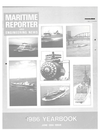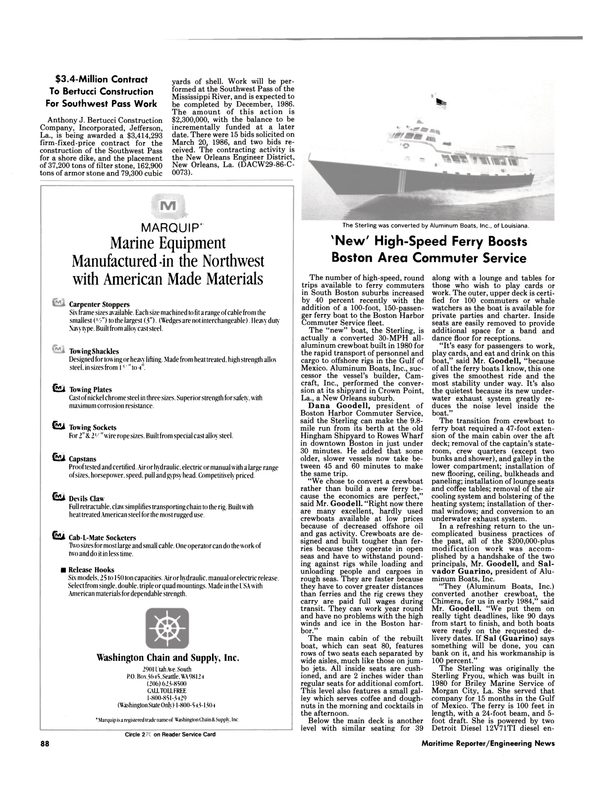
'New' High-Speed Ferry Boosts Boston Area Commuter Service
The number of high-speed, round trips available to ferry commuters in South Boston suburbs increased by 40 percent recently with the addition of a 100-foot, 150-passenger ferry boat to the Boston Harbor Commuter Service fleet.
The "new" boat, the Sterling, is actually a converted 30-MPH allaluminum crewboat built in 1980 for the rapid transport of personnel and cargo to offshore rigs in the Gulf of Mexico. Aluminum Boats, Inc., successor the vessel's builder, Camcraft, Inc., performed the conversion at its shipyard in Crown Point, La., a New Orleans suburb.
Dana Goodell, president of Boston Harbor Commuter Service, said the Sterling can make the 9.8- mile run from its berth at the old Hingham Shipyard to Rowes Wharf in downtown Boston in just under 30 minutes. He added that some older, slower vessels now take between 45 and 60 minutes to make the same trip.
"We chose to convert a crewboat rather than build a new ferry because the economics are perfect," said Mr. Goodell. "Right now there are many excellent, hardly used crewboats available at low prices because of decreased offshore oil and gas activity. Crewboats are designed and built tougher than ferries because they operate in open seas and have to withstand pounding against rigs while loading and unloading people and cargoes in rough seas. They are faster because they have to cover greater distances than ferries and the rig crews they carry are paid full wages during transit. They can work year round and have no problems with the high winds and ice in the Boston harbor." The main cabin of the rebuilt boat, which can seat 80, features rows of two seats each separated by wide aisles, much like those on jumbo jets. All inside seats are cushioned, and are 2 inches wider than regular seats for additional comfort.
This level also features a small galley which serves coffee and doughnuts in the morning and cocktails in the afternoon.
Below the main deck is another level with similar seating for 39 along with a lounge and tables for those who wish to play cards or work. The outer, upper deck is certified for 100 commuters or whale watchers as the boat is available for private parties and charter. Inside seats are easily removed to provide additional space for a band and dance floor for receptions.
"It's easy for passengers to work, play cards, and eat and drink on this boat," said Mr. Goodell, "because of all the ferry boats I know, this one gives the smoothest ride and the most stability under way. It's also the quietest because its new underwater exhaust system greatly reduces the noise level inside the boat." The transition from crewboat to ferry boat required a 47-foot extension of the main cabin over the aft deck; removal of the captain's stateroom, crew quarters (except two bunks and shower), and galley in the lower compartment; installation of new flooring, ceiling, bulkheads and paneling; installation of lounge seats and coffee tables; removal of the air cooling system and bolstering of the heating system; installation of thermal windows; and conversion to an underwater exhaust system.
In a refreshing return to the uncomplicated business practices of the past, all of the $200,000-plus modification work was accomplished by a handshake of the two principals, Mr. Goodell, and Salvador Guarino, president of Aluminum Boats, Inc.
"They (Aluminum Boats, Inc.) converted another crewboat, the Chimera, for us in early 1984," said Mr. Goodell. "We put them on really tight deadlines, like 90 days from start to finish, and both boats were ready on the requested delivery dates. If Sal (Guarino) says something will be done, you can bank on it, and his workmanship is 100 percent." The Sterling was originally the Sterling Fryou, which was built in 1980 for Briley Marine Service of Morgan City, La. She served that company for 15 months in the Gulf of Mexico. The ferry is 100 feet in length, with a 24-foot beam, and 5- foot draft. She is powered by two Detroit Diesel 12V71TI diesel en- gines developing 510 HP each at 2,100 rpm. Power for the ship's electrical and other systems is generated by two 40-kw Detroit Diesel 371 engines with Delco generators.
All of the vessel's communications and navigation equipment was retained including its two radars and aft control station.
The Boston Harbor Commuter Service operates under the aegis of the Massachusetts State Water Transportation System and the Mass. Bay Transit Authority. The fleet now totals four ferries, increasing the number of daily round trips from 10 to 14. The company serves about 1,200 commuters daily and approximately 1,600 during peak summer periods. A one-way trip is $3 which includes all-day parking at the ferry landing at Hingham. Daily parking rates in Boston range from $3 to $15.
The ferries also serve as feeders to the shuttle ferry serving Boston's Logan Airport.
For further information on services and facilities offered by Aluminum Boats, Circle 31 on Reader Service Card
Read 'New' High-Speed Ferry Boosts Boston Area Commuter Service in Pdf, Flash or Html5 edition of June 1986 Maritime Reporter
Other stories from June 1986 issue
Content
- Zapata Gulf Acquires All Assets Of Seahorse page: 5
- Rody Selects AWSC Committee Chairmen page: 5
- Danos & Curole Continue Long-Range Expansion In Marine Department page: 5
- Contract With $25-Million Potential Awarded Rockwell page: 6
- Nelson Electric Names Sanchez Sales Manager page: 6
- Bailey Refrigeration Goes On Site For Work Aboard Navy Aircraft Carrier page: 7
- Navy Awards $73.7-Million Crane Contract To Craft Machine page: 7
- ABS Elects New Members To Board Of Managers page: 8
- ASNE Symposium-1986 Set For October 2-4 In Biloxi, Miss. page: 8
- Ulstein Delivers Two Tug/Supply Vessels To Norwegian Owners page: 10
- Derecktor Delivers First Of Two Ferries To New York City page: 11
- AWO Elects Officers For 1986 At Annual Convention In Washington page: 11
- Pentagon Approves $216-Million Sale To Portugese Navy page: 12
- Sophisticated Catcher/Processor Delivered By Halter Marine page: 12
- ODECO Wins 1986 NOIA Safety In Seas Award page: 12
- Pickands Mather Promotes Three In Marine Department page: 13
- Monsanto Offers Free 12-Page Bulletin On Fluid Resistance Of Santoprene® page: 14
- Port Of Portland Budget Includes Funds For Marine Improvements page: 15
- American Bureau Names Twenty-Five New Members page: 15
- Port Authority In Malaysia Orders Voith Water Tractor page: 16
- Gastech 85 "Proceedings' Now Available page: 16
- Metos Marine Offers New Cabin Fitting Concept page: 17
- Meyer Werft Launches Two Sister Passenger Ships For Indonesia page: 18
- Fairbanks Morse Invests In Future— Expands Parts/Service Operations, Increases Production And R&D page: 20
- Borg-Warner Changes Name To York International page: 23
- Passenger Catamaran To Operate Between Seattle And Victoria page: 24
- U.S. SHIPBUILDING $Billions In Navy Work Plus Repairs Brighten The Picture page: 26
- STATUS OF NAVY SHIP PROCUREMENT page: 32
- U.S. SHIPBUILDING OUTLOOK Maritime Policy—1980-1985 page: 40
- U.S. SHIPBUILDING INDUSTRY HAS MADE GREAT STRIDES IN IMPROVING EFFICIENCY AND REDUCING COSTS page: 44
- Our Transportation Policy Is No Transporation Policy page: 46
- REGULATORY OVERKILL PERSERVERES page: 48
- AWSC And The Industry: Working For The Future page: 50
- Offshore Service Vessels, Tugboat And Inland Towboat Fleets page: 52
- CANADIAN SHIPBUILDING REVIEW AND OUTLOOK page: 63
- World Shipping And Shipbuilding page: 65
- Port of Iberia Inaugurates New Public Dock Facility page: 72
- Amhoist Announces $33 Million In Crane And Puller Orders page: 72
- Hancock Succeeds Loftus As Comptroller And Deputy Commander Of NAVSEA page: 73
- Gastech 86 Scheduled For November In Hamburg page: 73
- Technical Report On Liner And Bulk Planning Systems Offered By MarAd page: 74
- Todd's San Pedro Yard Gets Preliminary Approval As Foreign Trade Subzone page: 74
- Beclawat Offers Windows & Doors For Ships And Rigs page: 74
- Wartsila Unit Offers Vacuum Toilet System page: 75
- Ship Structure Committee Releases New Reports On Design And Safety Topics page: 75
- BIRKA LINE CRUISE SHIP DELIVERED BY VALMET page: 76
- American Management Now Provides Services For Commercial Ships page: 77
- Two More Firms Approve Use Of Ameroid® OWS page: 77
- MarAd Invites Proposals To Provide Vessel For Schoolship Conversion page: 77
- Port Authority Urges $56.5-Million In Funds For N.Y. Harbor Improvements page: 78
- Marine Travelift Offers Full-Color Brochure On 250-Ton Mobile Boat Hoist page: 78
- Bailey Controls Offers 18-Page Technical Paper On 0 2 / C 0 Boiler Control page: 78
- William O'Malley Named Executive VP At Sonat page: 79
- Free Literature Available On Long-Life Marine Window Wipers For Ships page: 79
- Jane's Publishing Offers Facsimile Edition Of First World's Fighting Ships page: 80
- Baldt Offers Military Shipbuilding Brochure page: 80
- York International Offers Brochure On Water Chilling And Condensing Units page: 81
- Norsk Pacific Announces Management Changes— Stenstrom Named President page: 81
- Deepwater, Heavy-Duty Jackup Joins Blue Streak Marine Fleet page: 82
- New Brochure Offered By Warren Describes Barge Pump Line page: 82
- M.A.N.-B&W Turbochargers Reduce Fuel Consumption page: 83
- SNAME Announces Standing Special And Technical Committees For 1986 page: 84
- Free 72-Page Catalog Describes New Falk Worm Gear Speed Reducers page: 85
- Free Full-Color Bulletin On AQP Spiral Wire Hose Offered By Aeroquip page: 86
- PRMMI Names Four To Key Sales Positions page: 86
- MHI Develops High-Pressure Gas Injection DFD Engine page: 87
- Free Four-Page Brochure Offered On Acorn Platens page: 87
- 'New' High-Speed Ferry Boosts Boston Area Commuter Service page: 88
- Microphor Offers New Four-Color Brochure On Marine Heads page: 89
- Cat Pumps Introduces Two N e w Stainless Steel Pumps page: 90
- Polarmarine Introduces New Concept In Tank Cleaning page: 91
- Tampa Shipyards Delivers Fifth Products Tanker To Ocean Shipholdings page: 92
- Caterpillar 3600 Series Now Qualified On 1,500 Redwood Fuel page: 92
- Bailey Controls Opens New Demonstration Facility page: 93
- Ulstein Maritime Reports On Z-Drive Success page: 94
- Degree In Small Craft Naval Architecture Offered By YDI Schools page: 95
- Montreal Group Plans To Modernize 150-Year-Old Yard In Nova Scotia page: 96
- Atlas-Danmark Expands Line Of Sludge/Waste Incinerators page: 97
- '86 Ship Production Symposium Scheduled For August in Williamsburg page: 98
- Sulzer Diesels Will Power Townsend Cross-Channel Passenger/Vehicle Ferries page: 99
- Marathon Offers Full-Color Brochure On Metal Fabrication Services page: 102
- Free 12-Page Catalog On Combustion, Pollution And Energy Control Equipment page: 102
- Free 16-Page Full-Color Brochure On Compressors Offered By Atlas Copco page: 103
- MM A Meeting Draws Immediate Return Engagement By DLA's General Morgan page: 104
- SAIT Radio Telex Now Compatible With IBM PC page: 104
- New York City Marine Society Celebrates 216th Annual Dinner page: 106
- Blount Marine Delivers 64-Foot Ferry To Prudence Island Navigation page: 109
- First Two Of Ten Bulkers For Greek Owner Christened At Hyundai page: 115
- The Shipmate RS-2000 Color Track Plotter page: 115
- MacGregor-Navire Link Span Installed At Port Of Plymouth page: 118
- Cathodic/Electrolytic Engineers Offer Replacement Anode Service For Antifouling Systems page: 119
- Record Land And Marine Lifts Set By Amhoist Cranes page: 119


